
Paubrasilia echinata is a species of flowering plant in the legume family, Fabaceae, and is endemic to the Atlantic Forest. It is a Brazilian timber tree commonly known as Pernambuco wood or brazilwood and is the national tree of Brazil. This plant has a dense, orange-red heartwood that takes a high shine, and it is the premier wood used for making bows for stringed instruments. The wood also yields a red dye called brazilin, which oxidizes to brazilein.
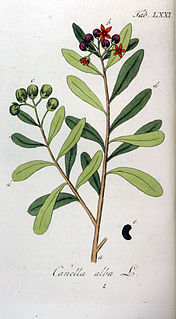
The Canellaceae are a family of flowering plants in the order Canellales. The order includes only one other family, the Winteraceae. Canellaceae is native to the Afrotropic and Neotropic ecozones. They are small to medium trees, rarely shrubs, evergreen and aromatic. The flowers and fruit are often red.

Carl Friedrich Philipp von Martius was a German botanist and explorer.

Vochysiaceae is a plant family belonging to the order of Myrtales.
Fouquieria formosa is a species of Fouquieria in the ocotillo family, native to central and southern Mexico.
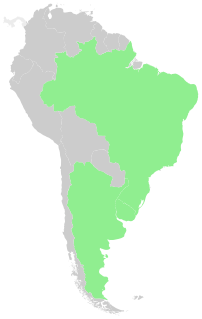
Senecio pulcher is an ornamental plant native to the wet valleys & slopes and flooded rocky habitats in Argentina, Brazil, and Uruguay. Cited in Flora Brasiliensis by Carl Friedrich Philipp von Martius. After dusty miller, S. pulcher is perhaps one of the most popular species of the genus for horticulture along with German ivy and purple ragwort or it was in 1917.
Aegiphila sellowiana is a species of tree or shrub in the family Lamiaceae. It is native to Bolivia, Brazil, and Ecuador. Its common names include tamanqueira.
Garcilassa is a genus of flowering plants in the sunflower family.

Eduard Fenzl was an Austrian botanist.

Psittacanthus robustus is a species of neotropical mistletoe in the family Loranthaceae, which is found in Brazil, Colombia, Guyana and Venezuela.
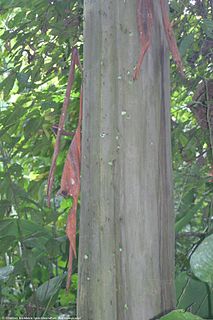
Calycophyllum spruceanum, is a canopy tree indigenous from the Amazon rainforest.
Passiflora bryonioides, the cupped passionflower, is a plant in the genus Passiflora, family Passifloraceae. It is native to Arizona, Sonora, Chihuahua, Sinaloa and Guanajuato.

Burmannia capitata is a plant species widespread across the West Indies and much of Latin America. It grows in wet areas at elevations less than 100 m. It has been reported from Argentina, Belize, Bolivia, Brazil, Cuba, the Dominican Republic, Haiti, Jamaica, Puerto Rico, Trinidad & Tobago, Colombia, Costa Rica, French Guiana, Guyana, Honduras, southern Mexico, Nicaragua, Panamá, Paraguay, Suriname, Venezuela, and the United States

Zephyranthes minuta is a plant species very often referred to as Zephyranthes grandiflora, including in Flora of North America. The latter is, however, an illegitimate name because the original author in coining the name Zephyranthes grandiflora listed the older name Amaryllis minuta as a synonym. This makes "minuta" the acceptable epithet under the ICN. It is a recipient of the Royal Horticultural Society's Award of Garden Merit.

Schubertia is a genus of flowering plants in the family Apocynaceae, first described as a genus in 1810. It is native to South America.
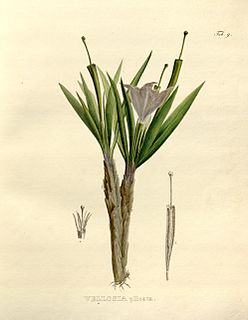
Nanuza plicata is a plant species in the family Velloziaceae, endemic to Brazil.

Nanuza is a plant genus in the family Velloziaceae, described as a genus in 1976. The entire genus is endemic to Brazil.
Eremitis is a genus of bamboo plants in the grass family, that is endemic to Brazil.
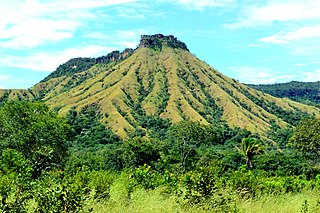
The Lajeado State Park is a state park in the state of Tocantins, Brazil. It protects a fragile, dry, hilly environment near the state capital of Palmas.














